What is Brand Protection, and from what is Such Protection Sought?
Brand protection is the strategic means to safeguard the IP and non-IP assets of an entity and its associated brands against real and potential infringers. The brand protection strategy plays a prime role in harnessing the economic value of a brand along with its name, image, reputation, and overall value.
The protection is majorly sought against all kinds of brand abuse against which the entity should remain vigilant at all times. These may include but are not limited to:
- Brand Counterfeiting: It refers to the imitations or duplicates of a branded product utilizing fake trademarks without authorization to deceive consumers. By the year 2022, the global counterfeiting industry is predicted to be worth $4.2 trillion.

- Malicious Websites: Malicious websites are created by infringers to damage the brand and may take the following different forms:-
- Cyber-squatters
- Typo-squatters
- Imitation websites
- Piracy of Copyright: Copyrighted articles like art, literature, computer programs are often sold at cheaper rates by illegitimately utilizing proprietors’ rights for unauthorized profits and gains. The same holds for books and DVDs.
- Trademark Squatting: Squatters register names that are a sound-alike or look-alike of authentic marks with bad faith attached.
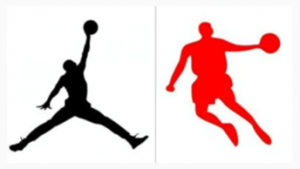
Jordan vs. Qiaodan Mark For example, the Jordan case where the squatter used the Qiaodan mark.
- Online Impersonation: It happens when the infringer poses himself to be the actual proprietor of the brand by using its trademarked logos and copyrighted assets.
Role of IP in Protecting a Brand
IP plays a crucial role in devising the brand protection strategy. Different IP routes can be taken in furtherance of the achievement of this goal. They are:-
1) Trademarks: To put it straight, trademarks and brands are not the same and hence, cannot be used interchangeably. Where a trademark will help differentiate between the goods of two proprietors and identify the source of origin, brands have more complex features. The image building, status, value of the personality of the brand, and consumer association are all the intrinsic features that constitute a brand. A brand not only helps in consumer association but also develops the corporate existence of an entire company to fulfill a wide range of goals. However, both trademarks and brands help in identification; they play different yet overlapping roles.
A trademark is a device, brand, heading, label, ticket, name, signature, word, letter, numeral, shape of goods, packaging or combination of colors or any combination thereof, which helps differentiate between the goods and services of one from that of another.  The use of a trademark helps secure the exclusive right to use the brand name or device and prevent misuse by imitators. It also helps build brand loyalty amongst existent and potential consumers, which adds-on to the feature of the ‘quality’ of the mark.
The use of a trademark helps secure the exclusive right to use the brand name or device and prevent misuse by imitators. It also helps build brand loyalty amongst existent and potential consumers, which adds-on to the feature of the ‘quality’ of the mark.
Therefore, a trademark helps a brand to shift from a product-level brand to a corporate-level brand by attaining a certain amount of goodwill, which also depicts the interplay of trademarks and brands. The same is the most commonly adopted strategy due to its ease of operation and registration. A few examples include Nike’s Swoosh, Chanel’s representation of ‘C,’ Twitter’s bluebird, and Adidas’ three stripes logo.
2) Trade Dress – A brand can also be identified by the use of a distinct trade dress. The way a trademark helps identify the source of a product, a trade-dress serves an identical purpose. Trade dress often takes the form of labels and designs of packages like the Coca-Cola bottle (Tm. Reg. No. 1,057,884). The dress is composed of the look and feel of the product with distinct yet consistent specificity. A functional feature or a design aiding the function of a product cannot be protected. Other brands that have considered trade dress protection include Converse for its ‘hi-top’ shoes, Hershey’s for its ‘Hershey Kiss’ chocolates, Burberry for its check pattern, Christian Louboutin for its red sole, and the list goes on.
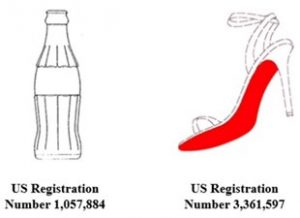 The threshold for seeking protection is often higher than trademarks, and therefore, requires a ‘secondary meaning’ to be proven, which means that the public identifies the design or the trade dress and relates it to a specific source. Hence, where a trademark may ensure immediate protection, seeking protection of a trade dress may relatively take lolonger. The Federal Court of the United States recently established the six-factor test in the Converse Inc. vs. ITC case where Converse alleged that the midsole design of its Chuck Taylor shoes had gathered sufficient goodwill and reputation. These factors are:
The threshold for seeking protection is often higher than trademarks, and therefore, requires a ‘secondary meaning’ to be proven, which means that the public identifies the design or the trade dress and relates it to a specific source. Hence, where a trademark may ensure immediate protection, seeking protection of a trade dress may relatively take lolonger. The Federal Court of the United States recently established the six-factor test in the Converse Inc. vs. ITC case where Converse alleged that the midsole design of its Chuck Taylor shoes had gathered sufficient goodwill and reputation. These factors are:
- Association of the trade dress with a particular source by actual purchasers (typically measured by consumer surveys);
- Length, degree, and exclusivity of use;
- Amount and manner of advertising;
- Amount of sales and number of customers;
- Intentional copying; and
- Unsolicited media coverage of the product embodying the mark
Once the secondary meaning is established, the trade dress can prevent illegitimate copying and infringement and can be a great branding strategy to build the reputation of a brand.
3) Design Patent: A design patent is granted for the ornamental features of a product, which are non-functional. It is for this reason why the court decided to invalidate two of Ford’s design patents covering the automotive-body parts for its F-150 truck (Auto. Body Parts Ass’n vs. Ford Global Techs., LLC, 293 F. Supp. 3d 690 (E. D. Mi. 2018)). The pre-requisite is that such a design should be new and non-obvious to the existing craft. It plays a crucial role in branding since the design forms the element that gathers the attention of the eye before actually using it. It helps appeal and lure consumers towards buying some specific product, and over time, it reduces the search-cost when the consumers adopt the product and absorb the brand image that comes with it.
 Design patents form a determinant role in the field of automotive and cellular devices to safeguard their branding and image. It is for this reason why Apple succeeded in a lawsuit against Samsung for Samsung infringed upon three of its design-patents covering its smart-phone technology inclusive of its appearance, as well as, the arrangement of the icons on its home screen. The protection afforded by design patents is a better alternative to trade dress protection since it does not mandate proof of established ‘secondary-meaning.’
Design patents form a determinant role in the field of automotive and cellular devices to safeguard their branding and image. It is for this reason why Apple succeeded in a lawsuit against Samsung for Samsung infringed upon three of its design-patents covering its smart-phone technology inclusive of its appearance, as well as, the arrangement of the icons on its home screen. The protection afforded by design patents is a better alternative to trade dress protection since it does not mandate proof of established ‘secondary-meaning.’
4) Copyright: Seeking Copyright Protection is a good strategy in furtherance of brand protection where the product involves original works of authorship, such as visual art, music, and literary works. It goes beyond the simple creation of works and can help in brand promotion and protection by safeguarding distinctive and original logos/emblems, labels, product-use manuals, and even advertisements. For example, in Maple and Co. vs. Junior Army and Navy Stores, an illustrated catalog for advertisement, which was not for sale, was held to be a subject matter of copyright.
However, not all types of artistic expressions are worthy of being protected under the law. In a case where the artistic elements of uniforms of cheerleaders were brought forth, the court held that the feature could be copyrighted if:
- It can be perceived as a work of art separate from the useful article; and
- It would qualify as a pictorial, graphic, or sculptural work eligible for protection if imagined separately from the useful article.
Therefore, before resorting to such protection, the strategists should keep in mind the points (mentioned above) of consideration to prevent contrasting objections to their claims. Copyright can be beneficial in the creation of a brand image in the long run since once the protection is sought, the brand’s entity has the exclusive right to reproduce, copy, display, perform or create derivative works from their copyrighted work.
5) Trade secret: Brand protectionists can undertake to choose an alternative to mandatory disclosure, which is required for all other kinds of IP except trade secrets. The same is more prevalent in the food & beverage industry.
Let’s take some widely known examples where brands have endorsed protection under trade secrets. The most common is the Coca-Cola secret recipe. Other examples are Listerine’s formula of Lambert Pharmaceuticals, the recipe of the Twinkies, McDonald Big Mac special secret sauce, Google’s search algorithm, KFC’s original recipe hidden in a safe. These choices also influence the marketing strategy of the brand.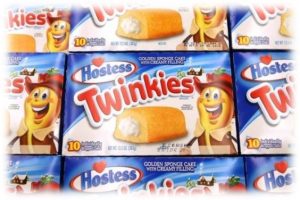
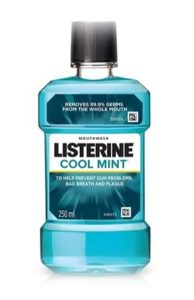
6) Overlapping IP: The best kind of protection that an entity can choose to protect and confine its brand against unlawful use is by deploying IP in layers. Let us take a hypothetical example of a food chain for better clarification. What kind of branding strategy aligned with IP be the most suitable in this scenario?
- The food chain can trademark its logo (device) and trade name (word).
- It can also claim Trademark Protection of its mascot, if any – for instance, Pillsbury’s Doughboy, Ronald McDonald, The Geico Gecko, and the Starbucks Mermaid. These can help in further merchandising options in the form of toys, stationery, apparel, etc.
- The employees’ uniform can be design protected.
- The recipe can either be copyright or a trade secret, depending on the purpose of taking either route.
- The cutlery and utensils for presentation can be design protected.
- The layout of the food-chain/restaurant, after having attained and established a certain degree of reputation through securing a ‘secondary meaning,’ can be protected in the form of a trademark.
- If there’s any jingle used for advertisement, the tune can be copyrighted. If distinctive, the tagline or jingle can be trademarked.
Other Modes of Protecting your Brand and Conclusive Remarks
From the above discussion, it can be adduced that there are many tools a brand strategist has at his disposal to protect the brand. Also, it is advised to use IP in the best possible way by layering its different forms for amplified results. In each instance, the strategists should carefully consider the tools that best suit the dissemination and protection of the product/service at issue.
To protect your brand, you should consider the following steps:
- Always register your IP assets to prevent unauthorized use and counterfeits.
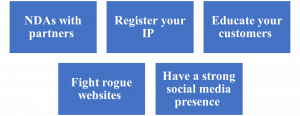
- Signing Non-Disclosure Agreements is a good option to prevent the draining of IP assets or their spillover. Such agreements help safeguard confidential information.
- Malicious websites should be kept under check by exercising continuous surveillance in terms of both online and offline operations.
- The establishment of a strong media presence helps in creating a brand image and attracting potential consumers while withholding the attention of existing consumers.
- Always be vocal in educating consumers of unwary trade practices, which might adversely affect consumer interest. They help differentiate between legitimate and fake products and services. 1. For view source: https://bit.ly/39kP8Xp
Don’t forget to follow us on social media:
Facebook – https://www.facebook.com/kashishipr/
Twitter – https://twitter.com/kashishipr
Linkedin – https://www.linkedin.com/company/kashishipr/
Pinterest – https://www.pinterest.com/kashishipr/
Tumblr – https://kashishipr.tumblr.com/
Contact - US
Email Id: kashishipr@kashishipr.com
Website: www.kashishipr.com

No comments:
Post a Comment